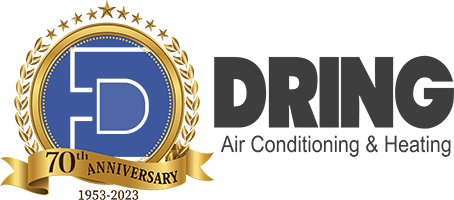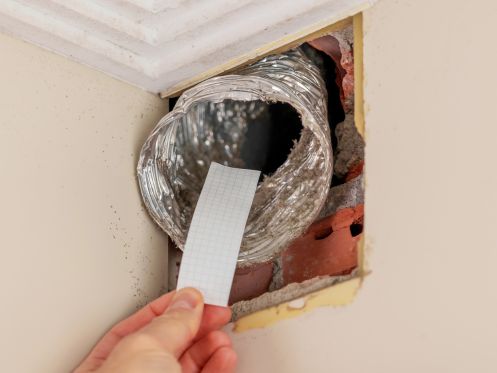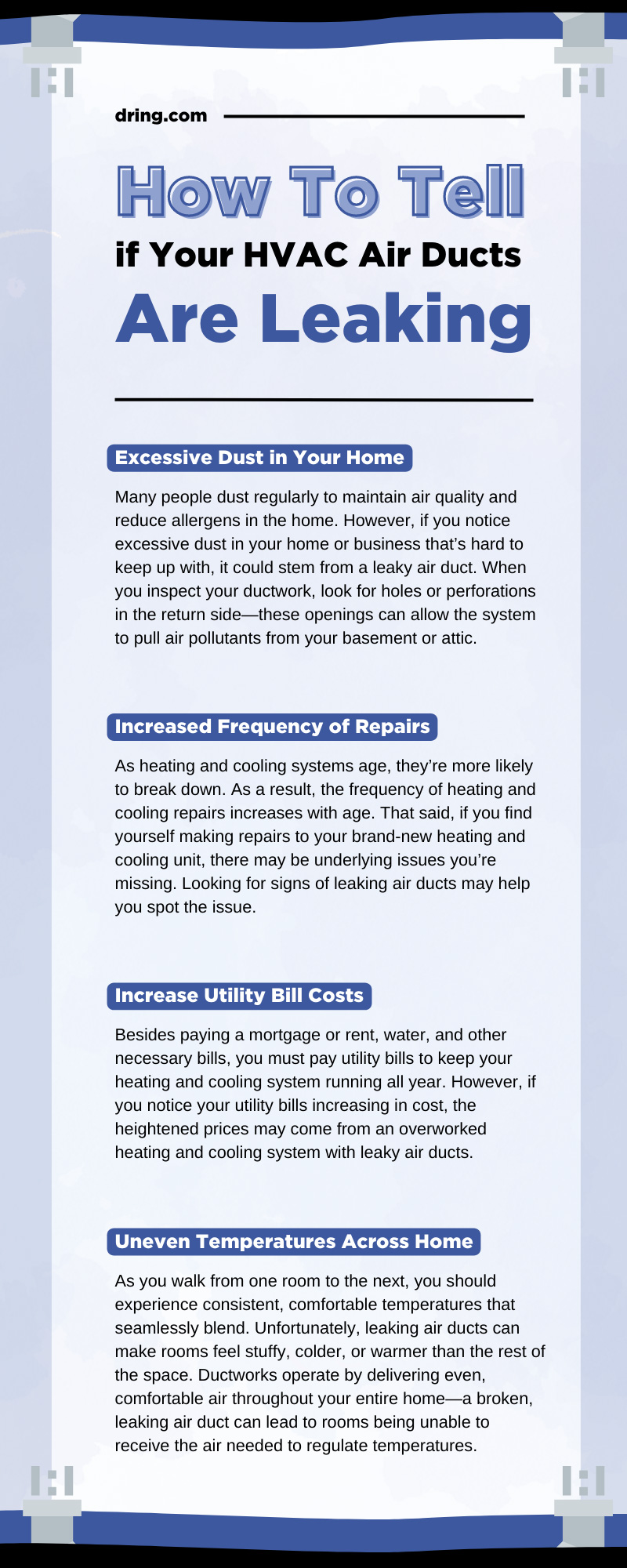While many people rely on heating and cooling systems, only some understand the fundamental pieces that allow these systems to function. For starters, heating and cooling systems rely on their air handlers, where the systems heat or cool the air. The blower resides inside a heating and cooling unit, acting as the fan that helps move the air. Heating and cooling systems aid in pulling air into one side of the unit and blowing out the other.
Air ducts on the side that pull air in are return ducts. The larger piece of the return duct that connects to the air handler is the return plenum. The blowing-side ducts, known as the supply ducts, contain a supply plenum connected to the air handler. This wide array of parts can, unfortunately, face several problems, with leaking being one of the most irritating. It could be time for repair if you notice these signs of heating and cooling air duct leaks.
Signs of Leaking Air Ducts
Leaks from your air ducts can create a frustrating situation that homeowners and business owners must handle immediately. Learning the signs of leaking air ducts can help with the repair process.
Excessive Dust in Your Home
Many people dust regularly to maintain air quality and reduce allergens in the home. However, if you notice excessive dust in your home or business that’s hard to keep up with, it could stem from a leaky air duct. When you inspect your ductwork, look for holes or perforations in the return side—these openings can allow the system to pull air pollutants from your basement or attic.
Once dust and debris enter your ductwork, it can spread throughout your home. No matter how much you clean, you will have difficulty fully removing dust from your residence. As a result of punctures or holes in your ductwork, your system will pull in more dust every time you turn it on.
Increased Frequency of Repairs
As heating and cooling systems age, they’re more likely to break down. As a result, the frequency of heating and cooling repairs increases with age. That said, if you find yourself making repairs to your brand-new heating and cooling unit, there may be underlying issues you’re missing. Looking for signs of leaking air ducts may help you spot the issue.
Newer heating and cooling units should operate with little to no issues for over a decade, especially if they receive proper maintenance. However, ductwork leaks can lead to further problems, such as system failure. Inspecting your ducts early on can help prevent unnecessary system issues from happening in the future.
Increase Utility Bill Costs
Besides paying a mortgage or rent, water, and other necessary bills, you must pay utility bills to keep your heating and cooling system running all year. However, if you notice your utility bills increasing in cost, the heightened prices may come from an overworked heating and cooling system with leaky air ducts. There are two possible issues: return side leakage and supply side leakage.
When leaking occurs on the return side, the ductwork sucks in hot air from your attic. As it progressively sucks air from the attic, it creates an unbalanced system, meaning more air enters your home than exits it. Professionals refer to this issue as positive pressure, and too much can push conditioning air outside the house through small gaps. Supply-side leaks occur when air ducts blow cool air into spaces that don’t need it, such as basements and attics. As a result, all the conditioned air you paid for goes to waste.
Uneven Temperatures Across Home
As you walk from one room to the next, you should experience consistent, comfortable temperatures that seamlessly blend. Unfortunately, leaking air ducts can make rooms feel stuffy, colder, or warmer than the rest of the space. Ductworks operate by delivering even, comfortable air throughout your entire home—a broken, leaking air duct can lead to rooms being unable to receive the air needed to regulate temperatures.
Tips for Repairing Air Ducts
Air duct repairs can take a considerable amount of time, especially if you have no history of air duct repair or knowledge. Implement some helpful air duct repair tips that can help you and your repair specialist identify the problem.
Excessive Air Duct Length
One considerable cause of dripping, leaky air ducts is excessive length. This problem can create resistance issues to your air ducts, which can reduce airflow and cause your system to produce more energy depending on the motor type moving the blower. While some installers leave additional duct length to help reduce noise, some don’t want to make that additional cut.
If you notice a considerable length on your air duct, such as 10 to 12 feet, it can have as much as 100 feet of resistance. Focus on disconnecting the duct from one end and removing as much excess length as possible. Reattach the duct with the inner liner and pull it tight.
Disconnected Air Ducts
Another sign of leaky air ducts is a disconnection. It’s one of the first things you should look for when inspecting your air duct. Suppose you notice air ducts blowing conditioned air into crawl spaces or attics and the return ducts sucking cold, humid, or superheated air into the system. These problems are primary signs of a disconnected air duct.
Many disconnected air ducts are easy to notice with the naked eye, but some require close inspection to find the source. Not all air ducts will have giant open fissures. Once you locate the disconnected air duct, use screws, clamps, zip ties, and staples as needed.
Poorly Insulated Air Ducts
There are instances where air ducts reside in unconditioned spaces, which can produce problems, especially with high summer heat and low winter temperatures. Fortunately, most air ducts have insulation to prevent functionality issues. If you notice signs of leaks, the issue could result from poor insulation.
The poorest duct insulation tends to reside in the connections—particularly around a duct boot. Duct boots are sheet metal fittings that connect to a duct from one side and a vent on the other. If you face uninsulated air duct system parts, the goal is to find and insulate problem areas.
Dring has offered its heating and air conditioning repair services to the Carrollton, TX, area since 1953. We focus on bringing exceptional repair skills and knowledge to our client’s homes all year. Our AC services in Carrollton include HVAC repair, maintenance, thermostat installation, humidifiers and dehumidifiers, and more. If you want to know more about our repair and installation services, reach out to our professionals today.








